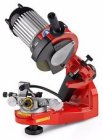I do take files when my chainsaw goes to the woods, just in case, but normally use a chain grinder in the shop since it is so much faster and can give a sharper chain. I first bought a cheap grinder from Northern Tool and learned my lesson. Got a good Oregon from Bailey's Online, my go-to for everything related to chainsaw and arborist things, PPE, etc..

www.baileysonline.com
If I can't find what I want on their website I just call - they've always been very helpful.
But the best thing to take to the woods is a spare bar and chain! Just swap with a worn chain and sharpen both when I get back to the shop.
Ever pinch a saw in a kerf? Just take off the head, put on the spare bar and chain, and cut the pinched one free.
Someone mentioned the excellent practice of flipping the bar at each sharpening and filing the bar smooth as it wears. Another thing is handy: after a while the groove in the bar can widen and the chain can get sloppy, lean from side to side, cause the cut to wander, and accelerate the wear. Long ago I bought a tool made for squeezing edges of the bar to better fit the chain and extend the life.
And one of the best things I got, the same month I bought this farm, was an education. Some was from several books but especially from this little book, "The Good Woodcutters Guide"
He explains the what and the how and the what NOT to do, warns against ways things can go wrong that can injure or kill.
How can you guard against what you can't imagine?
JKJ


